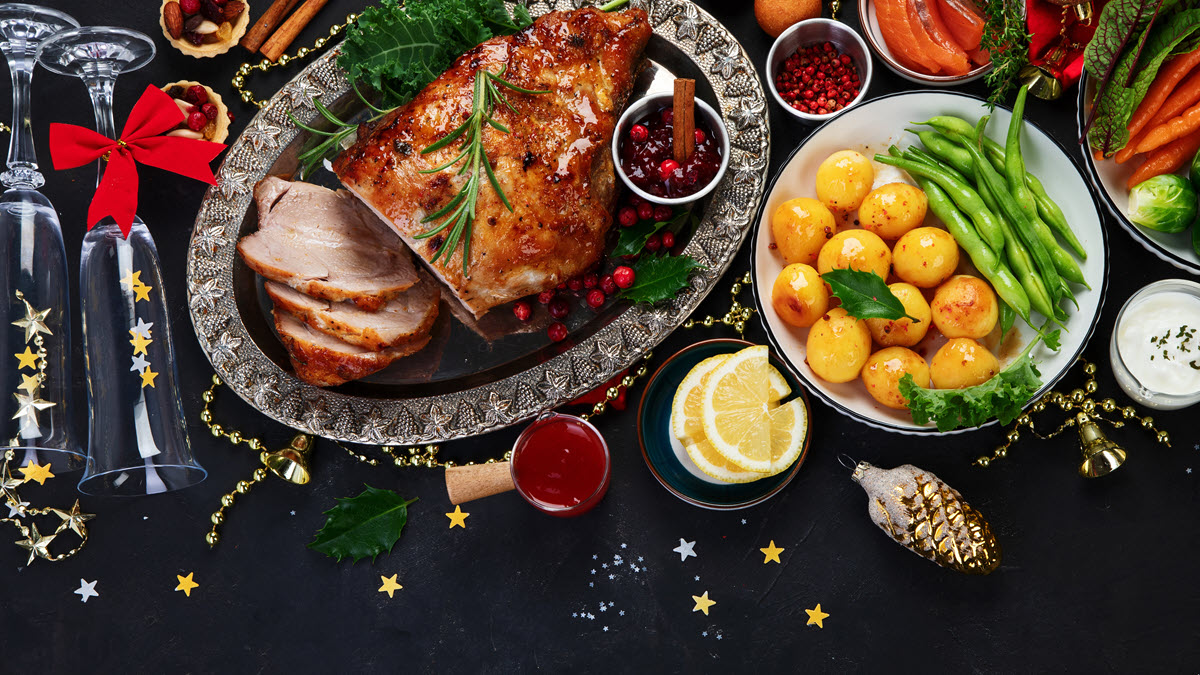
From heartwarming spices to mouthwatering umami-packed bites, tea enhances and elevates your dining experience. Transform traditional holiday main dishes into stunning showstoppers with tea-infused recipes. Then delight your guests with a tantalizingly aromatic tea cocktail that evokes happy nights spent around the family hearth. This holiday season, use tea to create a truly unforgettable feast.
The Flavors of the Season
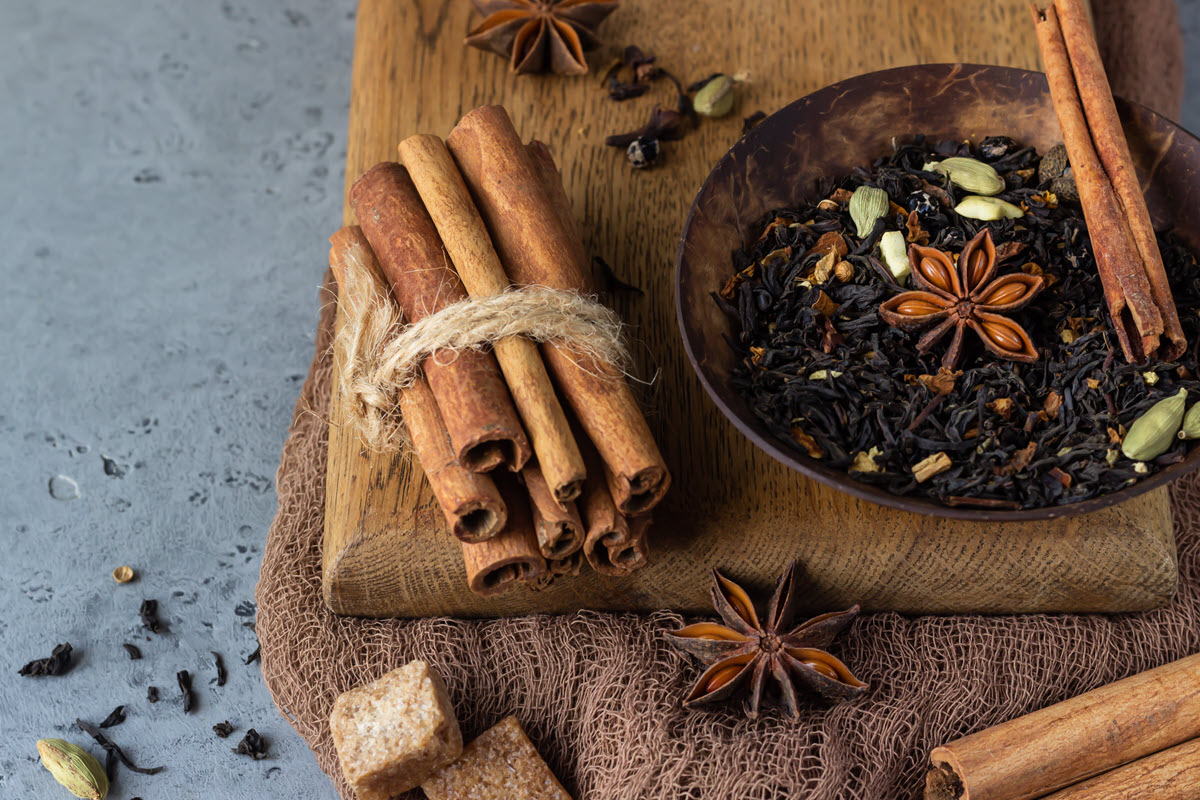
The same aromatic spices used in our favorite celebratory meals blend seamlessly with many different styles of tea. To help get inspired, I reached out to two well-known tea culinary and cocktail innovators, Lenny Martinelli and Yangdup Lama, to find out what they plan on cooking and drinking this holiday season.

Bio: Lenny Martinelli is the co-owner, Chef & CEO of the Boulder Dushanbe Teahouse & Boulder Tea Company. Highly regarded for their sustainable methods and organic farm, the Boulder Tea Company offers premium teas and herbal blends. Lenny was nominated for Best Tea-Inspired Chef at the 2023 World Tea Expo.
Diana: What sort of flavors do you associate with the holidays?
Lenny: Naturally, spices like cinnamon, clove, and ginger are things that are often considered “pumpkin spice.” But we also like to use chocolate and mint for the winter holidays. Other great flavors are eggnog or even sugar plum.
Diana: What traditions or special teas and food items do you do this time of year at the Dushanbe Teahouse?
Lenny: At the Teahouse, we do a special Holiday Afternoon Tea Service, which is just a little more ‘holiday’ themed than our regular service. We also offer limited edition holiday flavors of tea: Winter Spice, Gingerbread, Candy Cane Kisses
Diana: What are some of your favorite tea and food flavor combinations?
Lenny: We love to use spiced and sweet teas to accompany desserts. Fish and chicken dishes are beautifully paired with Japanese green teas, especially Sencha, GenMaiCha, or Gyokuro. Dishes with many spices are often nicely paired with oolongs, especially those from Taiwan, with their lighter but complex floral aromas and flavors.
Diana: Do you use tea to celebrate?
Lenny: Yes, especially Chai. Our chai has been a staple at our family holiday gatherings for over 20 years.
Diana: Have you encountered any fun teas on your travels?
Lenny: On our most recent travels to Tajikistan in October, we had some delicious spiced fruit teas. Whole spices and fresh slices of apple or lemon were placed in a teapot, steeped, and sweetened with honey to make a delightful infusion.
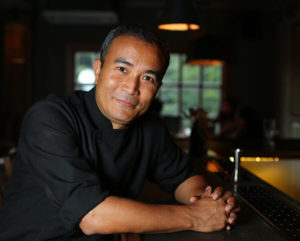
Bio: Yangdup Lama is considered one of India’s finest mixologists. He’s the proud co-owner of Sidecar, which is currently ranked #26 in the 2022 World’s 50 Best Bars and #14 in the 2022 Asia’s 50 Best Bars. He’s also an author and runs a successful service and beverage consultancy business. Yangdup was born in the Hill District of Darjeeling and spent his childhood playing amongst the tea plants.
Diana: How did growing up in Darjeeling influence your love for tea?
Yangdup: Actually, I never really drank tea growing up. We used to play in the tea gardens, and I remember picking the raw leaves and eating them to see what they tasted like, but I didn’t really learn to appreciate tea until I was older and moved to Delhi… Once I started bartending at the Hyatt Regency, I would drink tea behind the bar during my shift. Of course, the tea we served at the Hyatt was quite good, and I was surprised to see my hometown on the labels. I was lucky to have access to such good tea. Most people in India buy the mass-produced bag tea that’s sold in the supermarkets.
Diana: Do you use tea to celebrate the holidays in India?
Yangdup: Not so much, but then I went to school in Scotland, and that’s when I fell in love with the way the British celebrate the holidays: Afternoon Tea, tea cakes, and lots of pastries. I love those traditions.
Diana: You’re known for the innovative way you blend cocktails and tea. Do you feature tea on your cocktail menus?
Yangdup: Yes. Our present cocktail menu is called “ARQ,” an Urdu word for essence or aromas. We feature several tea cocktails, and I work closely with the Makaibari tea Estate in Darjeeling to create signature cocktails using their teas.
Diana: What flavors do you associate with the holiday season?
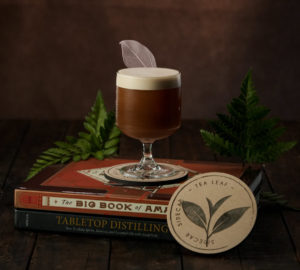
Yangdup: Whenever I think of the holiday or festival season in India, I immediately think of home—the aromas and flavors of Darjeeling. My strongest sensory memory of Darjeeling is the smell of smoked tea. Many people in that area grow their tea or buy it fresh from their neighbors. They don’t have a factory or place to process the raw leaves, so they place them on racks over their family’s hearths. As they cook throughout the week, the tea leaves begin to dry and whither, but they also absorb the smoke from the wood fire below. So whenever I smell the fragrance of pinewood, I instantly think of spending time with my family and friends around the fire, drinking tea, eating good food, and laughing. We make a great cocktail called the Tea Leaf that infuses Bacardi Quatro rum with Himilayan Pinewood Smoked Tea that tastes like home to me.
Four Tea-Infused Showstopping Mains
Give your favorite traditional holiday main dish a tea-flavored twist that your guests will love. From tea-brined ham to Assam spiced duck and prime rib served with Pu-erh au jus, there’s nothing tea can’t improve. Including a vegetarian hojicha tea and mushroom risotto that will have your meat-loving guests coming back for seconds.
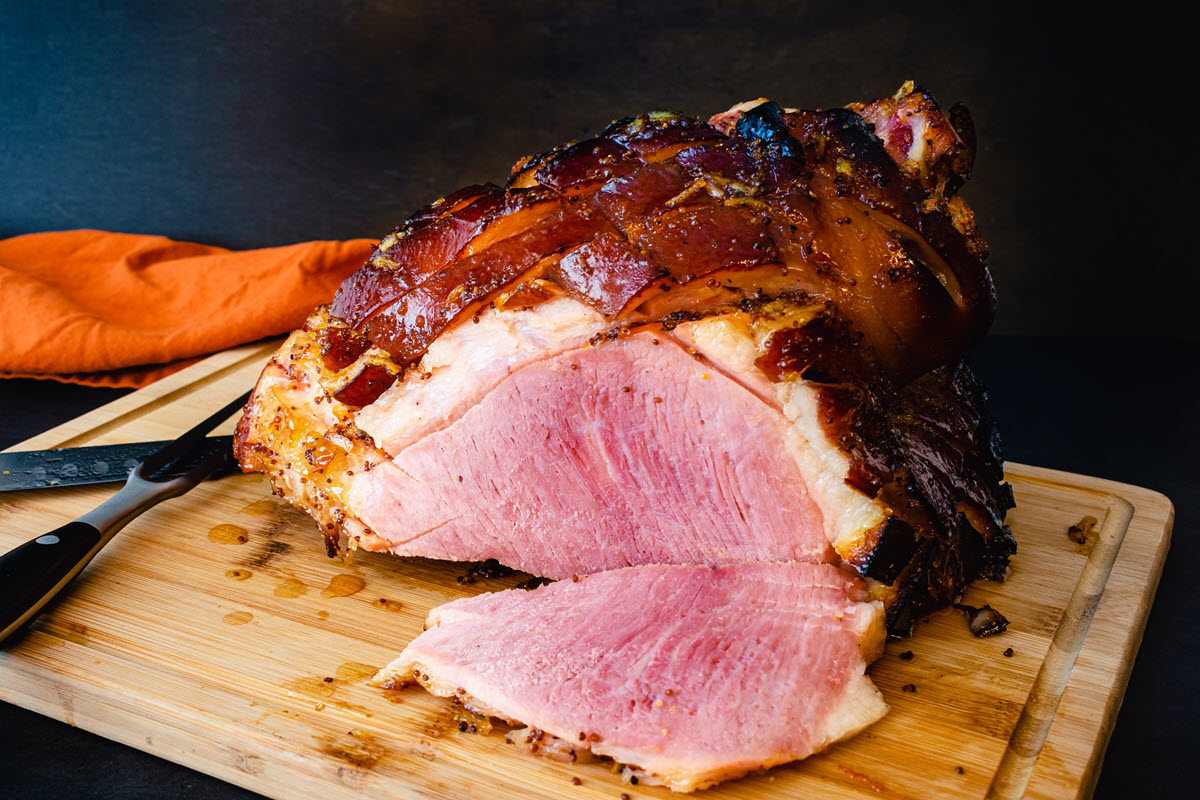
Tea Brined Ham Roast With Tea Spiced Glaze
A fresh ham roast differs from a fully cooked spiral cut or country ham. It has not been cured, smoked, or injected with sugar and salt. The benefit of cooking a fresh ham roast is controlling the amount of salt and sugar in your brine and getting that crispy, crunchy, crackling layer everyone loves.
A tea brine can be made with any tea you like. However, Cynthia Gold recommends using dark teas like Keemuns or Ceylons because the extra tannins in those teas help break down the protein and tenderize the meat. Then I like to use a holiday fruit tea such as the Glogg from Kushemi Tea with hibiscus, grape, and black currant notes to make a fruity spiced tea glaze.
Brining is when you submerge your protein in a solution of liquid, salt, and sugar for several hours or even days. This is especially good for lean meats such as turkey and chicken and the learner cuts of pork. Wet brines help the meat absorb extra flavor and retain moisture during cooking. This allows you to worry less, knowing your ham roast will be succulent on the inside and perfectly carmelized on the outside.
Tea Roasted Duck
Duck was never served at my family holiday meals growing up, but I wish it had been. It seemed like the most glamorous and special holiday dish. It took me years to get over the intimidation I felt towards cooking duck at home because of its reputation for being fussy and difficult.
Then I discovered this recipe for Assam Crispy Duck by Jamie Oliver and realized that duck doesn’t have to be that complicated. What I love about this recipe is that it’s super simple to make, smells amazing, and is incredibly satisfying.
While Jamie uses Assam black tea and creates an Asian-inspired gravy, I love to get creative and use my favorite spiced tea blends to flavor the duck and sauce. Consider deglazing the pan with delicious port or sherry to elevate it even more.

Standing Prime Rib Roast with Pu-erh Au Jus
Juicy, tender, and full of flavor, I don’t know if there’s anything more delicious than a perfectly cooked prime rib roast. Especially when served with an au jus enhanced by a ripe Pu’er tea’s rich, earthy, and woodsy flavors. Be sure to turn this recipe into the gift that keeps on giving by using the leftovers to make mouthwatering French Dip sandwiches the next day.
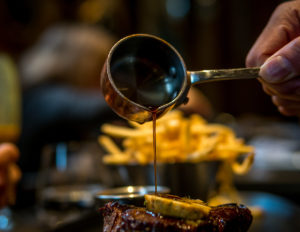
Follow these simple rules to make a flawless prime rib roast every time.
- Look for roasts with a lot of fat running through the middle of the cut. This ensures the meat stays moist as it cooks.
- Buy a roast with the bones in, but ask your butcher to cut them off and retie them with string. This helps insulate the outer edge from overcooking but makes for easy carving when you’re ready to serve.
- Season with lots of salt and let it rest in the refrigerator uncovered for at least an hour, preferably 24 hours before cooking. I only use salt and pepper to season my prime rib roasts because the beef tastes amazing on its own. The Pu-erh Au Jus adds extra depth and flavor at the end.
- Cook it low and slow. Many people recommend browning the roast first, but Kenji Lopez-Alt from Serious Eats has conducted many experiments and proven that the best method is to wait until the end to brown the roast. Take it out of the oven and let it rest until you’re almost ready to eat. Then, put it back in at the highest setting for a few minutes to achieve that perfect caramelized crust and beautiful pink center.
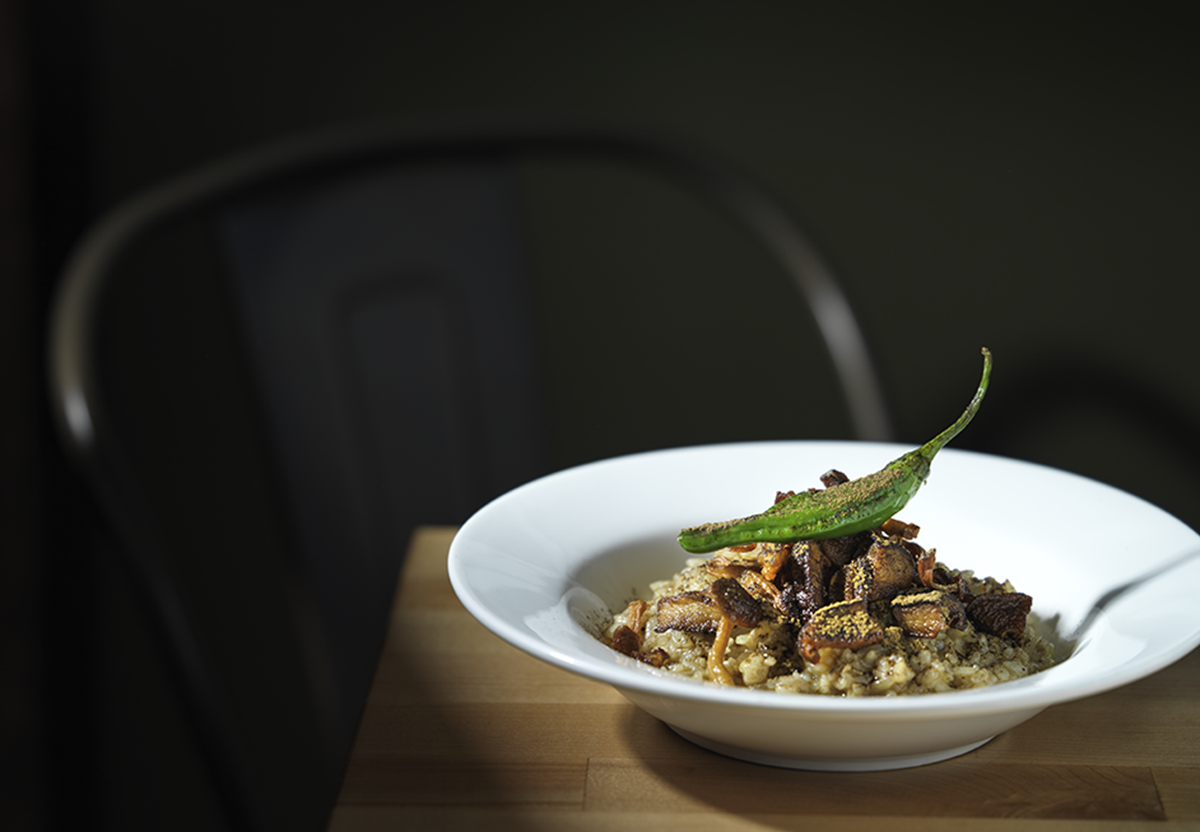
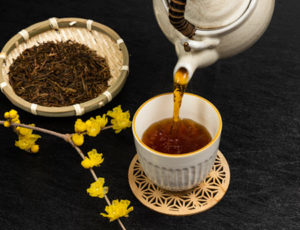
Hojicha Tea and Mushroom Risotto
This vegetarian main dish is packed with the sumptuous flavors of shitake and Bunashimeji mushrooms. When combined with the sweet, nutty, toasted notes of hojicha tea, you get a bold burst of umami flavor with every bite. It’s the kind of vegetarian dish that converts even the most diehard meat lovers to the green side.
Hojicha is a roasted Japanese green tea with low caffeine and a smokey, almost chocolatey taste. Sugimoto Tea worked with the renowned Yoroshiku restaurant in Seattle to create a morish dish highlighting their exquisite hojicha tea.
Enhance, Elevate & Enjoy
Using tea to enhance the flavors of your usual holiday main dishes is an easy way to wow your guests with something unique and unexpected. Cooking a holiday feast doesn’t have to be stressful or predictable. Have fun using tea to elevate your holiday meals and enjoy the loving sentiments of this festive season.
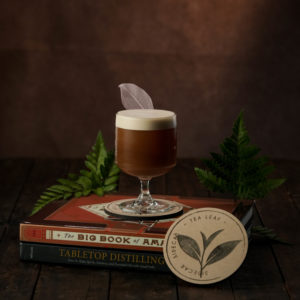
Tea Leaf Cocktail
Equipment
- 1 Candy thermometer or meat thermometer
- 1 Lg stockpot deep enough to submerge a bottle
- 1 Citrus juicer or small strainer
- 1 Cocktail shaker with bar strainer
- 1 Rocks glass
- 1 Fine Mesh Strainer or cheesecloth
Ingredients
Smoked Tea Infused Rum Sous Vide
- 500 ml Bacardi Quatro Rum or any aged rum
- 50 grams Himalayan Pinewood Smoked Tea or Lapsang Souchong
For the Cocktail
- 60 ml Smoked Tea Infused Rum
- 3 drops Ginger bitters
- 10 ml Simple syrup half a cup of sugar dissolved in half a cup of water
- 10 ml Lime juice
- 1 Egg white discard the yoke
Instructions
Infuse the Rum
- Using a candy thermometer, heat water in a large stock pot up to 60 C (140 F).
- Place the loose-leaf tea and room in a heatproof glass jar or plastic container. Seal the lid and submerge it in the warm water. Leave the infusion in the water for 30 minutes. Top up with more warm water every 5 minutes to maintain 60 C (140 F).
- After 30 minutes remove the rum infusion and strain out the tea leaves using a fine mesh strainer or cheesecloth.
Make the Cocktail
- In a cocktail shaker filled with ice pour all of the cocktail ingredients and shake well.
- Strain into a whisky (rocks glass filled with a clear ice cube/sphere).
- Garnish with a tea leaf skeleton.
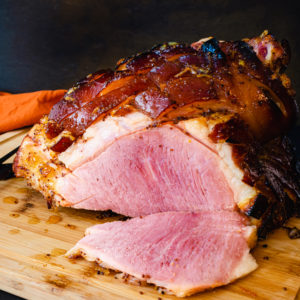
Tea Brined Ham Roast With Tea Spiced Glaze
Equipment
- 1 Large stock pot
- 1 2 gallon container
- 1 Large roasting pan
- 1 Turkey baster Or large spoon
- Paper towels
- Aluminium foil
- 1 Meat thermometer
Ingredients
Tea Brine
- 1/4 cup Black tea leaves Keemun or Ceylon, something with a lot of tannins
- 3 cups Water
- 3/4 cup Kosher salt
- 3/4 cup Sugar
Ham Roast
- 3-5 lb Fresh ham roast
- 2 tbsp Kosher salt
- 1 tbsp Fresh cracked black pepper
Spiced Tea Glaze
- 1/2 cup Dark maple syrup
- 2 tsp Fruity Spiced Black Tea Like Glogg from Kushemi Tea
- 1/2 cup Fresh squeezed orange juice
- 1/4 cup Red wine vinegar
- 1/4 cup Boiled water
Instructions
Make Tea Brine
- Bring 3 cups of water to a boil.
- Stir in black tea leaves, sugar, and salt. Stir until the sugar and salt dissolve.
- Allow the brine and tea to steep for 15 minutes. Set aside to cool.
Make The Ham Roast
- Once the brine has reached room temperature place the ham roast in a 2 gallon container and pour in the tea brine. Add enough cool water to completely cover the ham roast.
- Use a dinner plate to weigh the roast down so that it stays submerged in the brine.
- Cover and refrigerate the mixture for 6-24 hours.
- Remove the roast from the refrigerator and rinse off the excess brine. Then pat it dry with paper towels.
- Preheat your oven to 350 F ( 176 C).
- Place the ham into a large roasting pan.
- Score the top layer of fat with a sharp knife, making diamond patterns in the ham.
- Then rub kosher salt and black pepper all over the ham and into the cuts in the fat.
- Add enough cold water to the roasting pan so that it comes up to about 1 inch on the side of the roast.
- Cover the roasting pan in foil. Wrap it tightly so that it seals in the steam. This will help keep the ham moist as it roasts.
- Place the pan in the oven and roast the ham for about 2 hours. Or until its internal temperature reaches 160 F- 180 F. Then remove it from the oven.
- Crank the oven up to 450 F
Make the Spiced Tea Glaze
- Add spiced tea to the boiled water and let steep for 5 minutes. Then strain out the tea.
- Stir in maple syrup, orange juice, and red wine vinegar.
- Remove the foil from the roasting pan and put it back in the oven.
- Set the timer for 10-15 minutes. Pour the glaze over the ham and bast it every 5 minutes or so.
- Turn ham over to brown and baste the other side for another 10-15. At this point, the water in the pan should almost be evaporated.
- Remove the ham from the oven and let it rest for 30 minutes.
- Cover the ham with the remaining glaze and liquids from the pan while it's resting.
- Once it's rested carve, serve and enjoy.
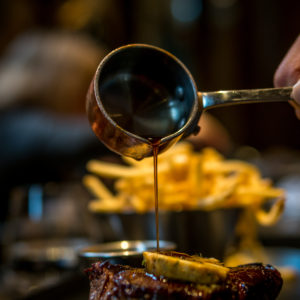
Pu-erh Beef Au Jus
Equipment
- 1 Fine Mesh Strainer
- 1 Whisk
- 1 large saute pan
Ingredients
Pu-erh Tea Concentrate
- 2 tsp (6g) Loose-leaf ripe Pu-erh tea (Shou Cha) Or you can use a dark oolong tea like Dong Ding
- 1 cup Water
Au Jus
- 4 tbsp Beef drippings Or unsalted butter
- 2 Shallots chopped
- 1 Carrot chopped
- 4 Stalks of celery chopped
- 2 Cloves of garlic chopped
- 1 tbsp Flour Or gluten-free flour
- 2 Sprigs of fresh thyme chopped
- 1 tbsp Worcestershire Sauce
- 2 tsp Dried Porcini mushroom powder
- 1 cup Concentrated Pu-erh tea
- 2 cups Homemade beef stock Or high-quality store bought
- Salt and pepper to taste
Instructions
Brew the Tea Concentrate
- Add 2 tsp or 6g of tea leaves to 1 cup of boiled water. Let it steep for 5-7 minutes, you want it extra strong.
- Strain out the leaves.
Make the Au Jus
- Heat a large saute pan over medium-high heat and melt the beef drippings or butter.
- Then add in the chopped shallots, carrots, and celery and a pinch of salt and black pepper.
- Saute until slightly translucent.
- Then add in the chopped garlic and saute for another 2 or 3 minutes.
- Whisk in the flour and saute for another 2 minutes, stirring constantly so the flour cooks but doesn’t burn.
- Add in the chopped fresh thyme and stir.
- Stir in the Worcestershire sauce and continue to stir. Make sure to get all the brown bits scraped off of the bottom of the pan.
- Add in the Porcini powder and stir a few times before pouring in the Pu-erh tea concentrate.
- Stir continuously for 2 minutes until the sauce begins to thicken.
- Then add in the beef stock and bring the sauce to a boil.
- Then reduce to a slow simmer uncovered for about 15 minutes.
- Once the sauce has reduced and thickened add salt and pepper to taste.
- Using a fine mesh strainer, strain out the solids so that you’re left with a rich velvety sauce.
- Serve immediately or refrigerate. Sauce will last 3-4 days in the fridge.
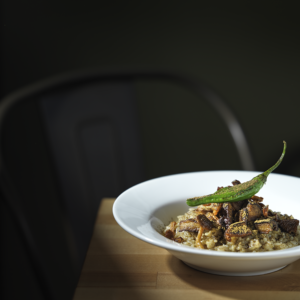
Hojicha Mushroom Risotto
Equipment
- 1 Small Sauce Pan
- 1 large saute pan
- 1 small strainer
- 1 Spatula
Ingredients
- 2 tbsp loose leaf Hojicha tea
- 1 cup Water
- 1 tsp Hojicha powder
- 1/4 cup Shitake mushrooms
- 1/4 cup Bunashimeji mushrooms
- 2 tbsp Unsalted butter reserve 1 tbsp for later
- 1 tbsp Extra virgin olive oil
- 1/2 tsp Chopped garlic
- 1/4 cup Minced onions
- 1 cup Cooked rice
- 1/4 tsp Salt
- 1/2 cup Parmiggiano-Reggiano cheese
- 1 Shishito green pepper fried in oil or roasted
- 1 pinch Ground cayenne pepper optional
Instructions
Brew the Hojicha Tea
- Brew loose leaf Hojicha using 2 Tbsp of tea in 1 cup of 200°F hot water for 3 minutes.
- Strain tea leaves out and set brewed tea aside.
Make the Risotto
- Fry Shitake and Bunashimeji mushrooms in 1/2 Tbsp of butter until the edges are crispy and remove from pan.
- Add remaining butter, olive oil, garlic, and onions to a hot pan and fry.
- Put boiled rice, brewed Hojicha, and salt in the pan.
- When the rice has heated up and is starting to get softer, add ground cayenne pepper and cheese.
- Cook until cheese has emulsified with the rice and tea.
- Plate and garnish with olive oil. Shishito, and a sprinkle of Hojicha Powder.
Notes
Tea Market
Get More Value from Your Tea: BRU Maker One
+41794574278
Jacque's Organics
(647) 804-7263
Beautifully written, loved the personal holiday memories of each person interviewed. Looking forward to trying the Ham recipe. Well done